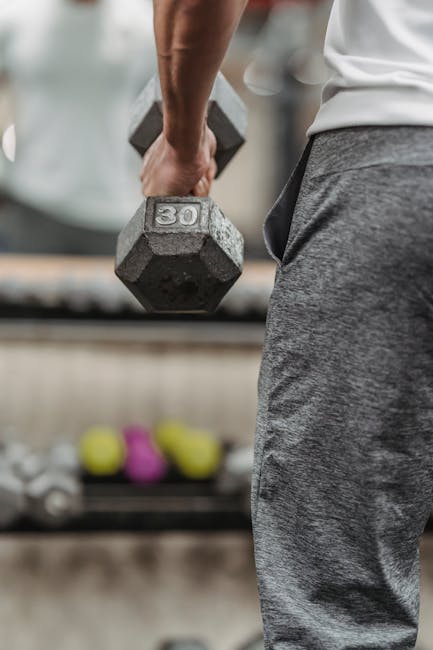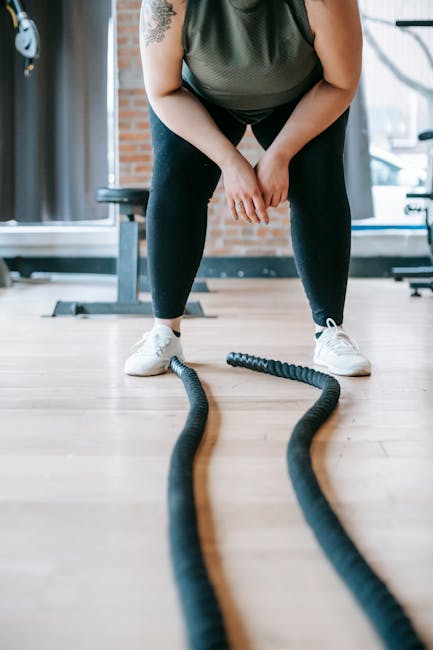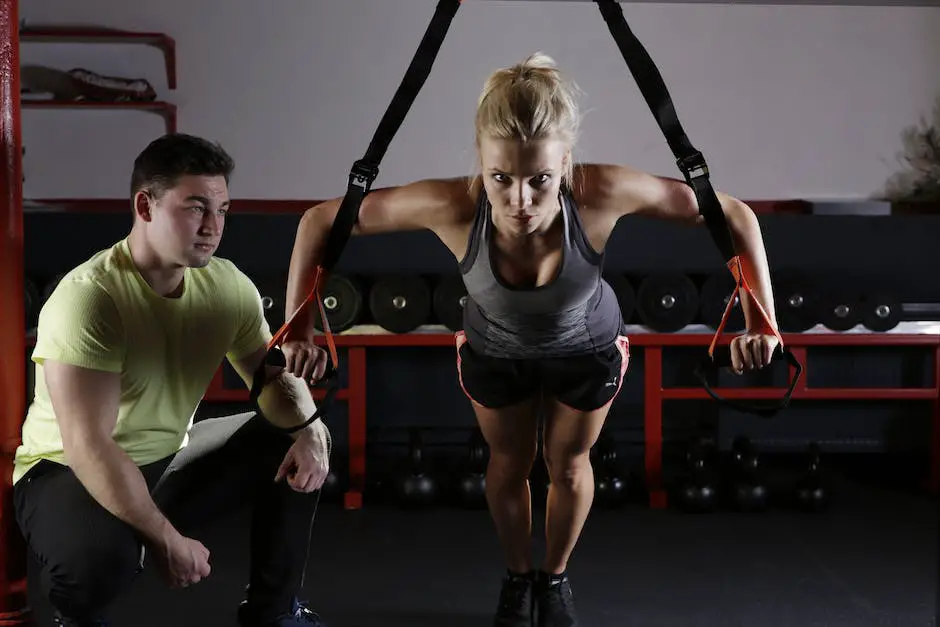Ladies and gentlemen, welcome to the world of weight lifting where you can sculpt your body into a chiseled masterpiece. Unfortunately, sometimes the price of this transformation can be painful. We’re talking about back pain, that uninvited guest who crashes your weight-lifting party and ruins the fun. But don’t worry, we’ve got your back – pun intended. In this article, we’ll give you some tips and tricks that’ll reduce back pain so you can continue lifting without a hitch, sweat, or tears. Let’s lift!
Contents
- 1 1. Introduction: Understanding the Causes of Back Pain from Weight Lifting
- 2 2. Proper Lifting Technique: Essential Steps to Preventing Back Strain and Injury
- 3 3. Warm-Up and Cooling-Down: Important Tips to Reduce Muscle Stiffness and Soreness
- 4 4. Strengthening Exercises: Effective Ways to Improve Core Stability and Spinal Support
- 5 5. Rest and Recovery: Strategies to Minimize Back Pain and Optimize Training Results
- 6 Rest and Recovery: Strategies to Minimize Back Pain and Optimize Training Results
- 7 Say Goodbye to Back Pain and Hello to Gainzzzz
1. Introduction: Understanding the Causes of Back Pain from Weight Lifting
If you’re someone who spends a considerable amount of time lifting weights, then back pain is probably something you are well acquainted with. While everyone may get sore muscles after a heavy lifting session, back pain is a different ball game altogether. Understanding the causes of back pain from weight lifting is key to preventing it from happening again.
The primary cause of back pain from weight lifting is due to poor form. Lifting weights with bad form puts undue pressure on your spine and other supporting muscles. This can lead to a strain in your lower back or even an injury in the long run. So, next time you hit the gym, don’t skip on form training, or else you might end up looking like the hunchback of Notre Dame.
Out of irritation and impatience, many of us tend to lift heavier weights, which is another primary cause of back pain. Gradual increments in weight are the way to go, and if you’re going to challenge yourself, do it under the supervision of an experienced trainer. Otherwise, you’ll end up lying on the mat, feeling sorry for yourself, and questioning every life choice you’ve made up until that point.
2. Proper Lifting Technique: Essential Steps to Preventing Back Strain and Injury
Let’s face it, nobody wants to deal with a sore back caused by improper lifting. So, if you’re tired of being laid up in bed with an ice pack on your spine, pay attention to these essential steps for preventing back strain and injury:
- Bend at the knees: You may think standing with your feet shoulder-width apart and bending over to pick something up is the way to go, but it’s a one-way ticket to back pain. Instead, squat down by bending at the knees, keeping your back straight, and hold the object close to your body. Trust us, your back will thank you.
- Avoid twisting: Twisting while carrying something puts unnecessary pressure on your back and can lead to a painful strain. To prevent this, avoid twisting your torso and pivot your whole body in the direction you need to go.
- Ask for help: Don’t be too proud to ask for help when lifting heavy or awkward objects. Your friends and co-workers will thank you for not coming back to work with a pulled muscle and a sour attitude.
By following these simple steps, you can prevent back strain and injury and keep yourself in peak physical condition. So, go ahead, lift with confidence, and don’t forget to show off your newfound lifting skills to your friends and family.
3. Warm-Up and Cooling-Down: Important Tips to Reduce Muscle Stiffness and Soreness
So, you’re about to hit the gym? Great! But before you start working out like a beast, it’s essential to get your muscles ready for action. That’s why a proper warm-up is crucial. Not only does it prevent injuries, but it also lubricates your joints and increases blood flow to your muscles.
For your warm-up, start with some light cardio exercises that will elevate your heart rate. Jumping jacks, a brisk walk or jog on the treadmill, or even dancing to your favorite pump-up song are all excellent options. Next up, do some dynamic stretches that mimic the movements you’ll be doing during your workout. No need to go all Cirque du Soleil on us, simple stretches like leg swings, arm circles, and lunges should do the trick.
Okay, so you’ve crushed your workout, and now you’re feeling like a champ. But don’t rush out of the gym just yet! Cooling down is just as important as warming up. It’s all about gradually bringing your heart rate and breathing back to normal and easing your muscles back to rest. Take a few minutes to walk around, do some light stretches, or use a foam roller to massage your sore spots (that is, if you can handle the pain).
- Don’t skip these steps. You might think that you’re saving time, but believe us; it’s not worth the pain – unless you’re into that kind of thing (no judgment here).
- Stretching after your workout can improve your flexibility over time, making it easier to move around in everyday life.
- Remember to listen to your body. If you’re feeling particularly stiff or sore after a workout, take a rest day or stick to some low-impact exercises to give your body time to recover.
4. Strengthening Exercises: Effective Ways to Improve Core Stability and Spinal Support
Okay, so you’re looking to strengthen your core and support your spine. Good for you! No more slouching like a wilted plant. These exercises will have you standing tall like a mighty oak tree in no time.
But first…. a disclaimer:
Before jumping into any exercise routine, be sure to consult with your healthcare provider. We take no responsibility if you injure yourself doing these exercises while simultaneously attempting to film a TikTok.
1. Plank:
- Bend your arms, and place your forearms on the floor
- Extend your legs behind you, resting on your toes
- Hold this position for 30 seconds to one minute
- Feel free to imagine yourself as a piece of wood
- Pro tip: For an added challenge, try lifting one foot or one arm at a time
2. Dead Bug:
- Lie on your back with your arms extended towards the ceiling
- Bend your knees to a 90-degree angle
- Slowly lower your right arm towards the floor above your head while simultaneously extending your left leg straight out
- Return to the starting position and repeat on the other side
- Pro tip: For an extra challenge, try keeping your back flat against the floor
3. Bird Dog:
- Get down on all fours
- Extend your right arm straight out in front of you while simultaneously extending your left leg straight out behind you
- Hold this position for a few seconds and return to the starting position
- Repeat on the opposite side
- Pro tip: For an added challenge, try lifting both your arm and leg off the ground at the same time.
5. Rest and Recovery: Strategies to Minimize Back Pain and Optimize Training Results
Rest and Recovery: Strategies to Minimize Back Pain and Optimize Training Results
When it comes to fitness, most people focus on the training part and overlook the importance of rest and recovery. It’s like trying to drive a car with low fuel and worn-out tires. Sure, you might make some progress, but you’ll likely break down sooner rather than later. So, how can you optimize your recovery and minimize your back pain? Here are some tips to help you out.
1. Sleep like a baby
- Make sure you get at least 7-8 hours of sleep every night.
- Invest in a comfortable mattress and pillows that support your spine.
- Avoid using electronic devices before bed, as the blue light can disrupt your sleep cycle.
2. Stretch it out
- Do some stretching exercises after your workouts to release tension and improve flexibility.
- Consider taking yoga or Pilates classes to improve your posture and core strength.
- Use a foam roller or massage ball to loosen up tight muscles and knots.
3. Ice, heat, repeat
- If you experience back pain or inflammation, try applying ice or a cold pack for 15-20 minutes several times a day.
- If you have chronic pain or stiffness, heat therapy can work wonders. Use a heating pad or take a warm bath for 20-30 minutes.
- Alternate between ice and heat therapy as needed.
Remember, rest and recovery are just as important as training. If you don’t take care of your body, it won’t take care of you. So, sleep well, stretch often, and don’t be afraid to give your body the treatment it deserves.
Say Goodbye to Back Pain and Hello to Gainzzzz
Well, folks, we made it to the end! You’ve learned some valuable tips and tricks for reducing back pain caused by weightlifting, and hopefully, your next workout will be pain-free. Remember to always warm up properly, use proper form, and don’t be afraid to ask for help if you’re unsure about a particular exercise. And as always, don’t skip leg day – unless you want to be one of those unfortunate gym-goers with a massive upper body and toothpick legs. Stay strong, stay healthy, and keep crushing those PRs!








Leave A Comment